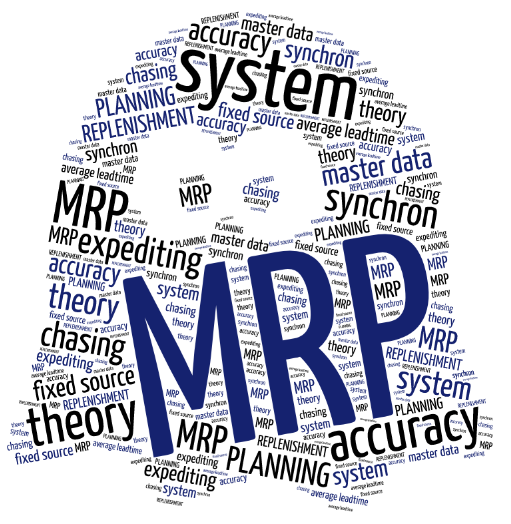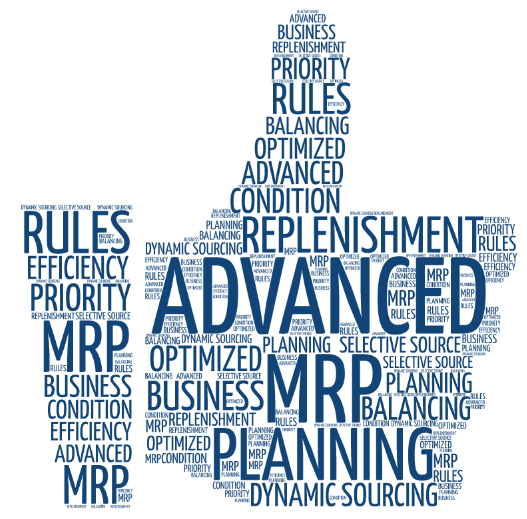Foreword
Within the MRP concept, Supply Chain actors expect master data to be exact, inventory to be accurate, customer demands to be known long in advance, forecast to be good and even better, and replenishment parameters to be close to reality. Many assumptions that are, in most cases, not true – because things move fast, organizations cannot keep up having every single data aligned, so as to achieve a planning satisfaction level close to 95%.
In other words, planning is never good enough to create it and forget about it until the next run. Yet execution teams take replenishment propositions from top to bottom, in full confidence, matching overall result and everyone’s expectations.
Diving in
One of the main reason MRP fails at giving coherent and foreseeable plans lies in its original design. It states that any demand must be treated in a chronological order, independently of any priority, condition, or economic goal.
This is theoretically valid; however, life is full of things that are not aligned with theory. I won’t just list all experts who said “The soft stuff is the hard stuff in MRP”. Google finds 83 900 occurrences of the expression. Whatever the efforts an organization places in tidying things up, we all as humans, introduce uncertainty and judgement, which eventually distort plans and deviate results.
Typical solutions to overcome MRP issues
-
- Do a bit more of tidying up tasks, which will pile up on tasks already in place – this is proven to be not sustainable over a prolonged period.
- Change the method to DD_MRP, LEAN… These are no doubt valuable paths, however, they represent large investments in terms of money, time and change management before you can reap the benefits – that is, if you eventually do. Choosing this way does not equate with ‘Let’s try to see if it works for us!’ To have a successful implementation with those methodologies, you first have to break the beliefs in old models, then heavily train, support, advocate, conduct change and make sure you have the relevant champions and sponsors to lead the journey to success.
-

3. Introduce changes in MRP calculation, to follow another way of going through the MRP planning sequence. Ideally, favor a solution light enough to be assessed easily, with little impact on people, organization and IS/IT.
4. Introduce Advanced Planning Systems, which all promise a lot – however, as the above-mentioned methods, are not easy to implement, have a significant cost, and often aren’t popular with the planning community.
At DOWAP, we believe the 3rd option is the one to try first, before even thinking of introducing bigger changes like a new methodology or IBP and APS.
Advanced MRP introduction
Advanced_MRP is a specific ABAP application developed by DOWAP, which allows you to maintain rules, specific master data, and to run planning calculations, this either in ECC or APO.
-

-
Based on many MRP implementations with unsatisfactory results, we came to develop an amended version of plan calculation, an alternative to the standard MRP engine, which we call Advanced_MRP. It offers our customers a powerful planning calculation approach, yet light enough to start creating plans within two weeks. The solution allows prioritization of demand types (order, dependent demand, forecast, safety stock reconstruction…) and the setting up of replenishment, also based on a prioritization of sources and replenishment methods, according to actual and planned data.
Advanced_MRP allows prioritization from a demand and replenishment perspective, so that replenishment process can allocate supplies to demand in the desired sequence. By so doing, planning can focus on service level by demand type, improve the profitability of the generated plan, and reduce actual shortages – all this with data continuing to vary significantly. With Advanced_MRP, you can create your own rules to better control how your planning run matches demands to replenishments in regards to your business model.
Advanced _MRP also allows for simulation scenarios that calculate plans, without any change in operational data, “Just to check” – these simulations calculate economic parameters like cost, revenue and margin attached to the scenario.
The typical standard MRP conundrum
A product is typically being planned against a forecast – however, customer orders are coming in in the short term. Priority levels may be conflicting with MRP prioritization of overdue forecast (laying in past) instead of giving the focus to actual sales orders. As a result, although planners spend a lot of time addressing priorities prior to releasing production orders, the production planners often re-schedule priorities based on orders – and not as expressed by planners. In the end, a lot of time is wasted in chasing production and procurement orders based on unstructured data input (shadow IT in Excel for instance).
The Advanced_MRP use cases
Beforehand, it may be important to mention what Advanced_MRP is not: it is no magic trick allowing you to forget processes, data, and let unruly practices go unchecked. It is designed to support you in weighing actuals and reality.
Case 1- A product is in a regular shortage situation with demand being higher than replenishment capabilities. By picking demand by order date, the scarce supply is not optimized and overall margin may seriously drop. Prioritizing demand during planning may give preference to more profitable demands first. This is particularly applicable when orders and forecasts are in competition.
Case 2- You wish to replenish the more profitable customer demands first, even before you serve safety stock reconstruction, this from other plants (factory or DC), for the next 2 weeks, to allow for a shorter lead time, whereas you would normally choose to replenish from main source after this initial period.
Case 3- You wish to replenish any demand, sorted by priority on the demand location, from any leftover stock from other listed plants, before even placing new production/procurement order. You wish this to be dynamically determined at each run, to benefit of leftover quantities from other sites.
You will certainly have experienced many other different use cases, for which you had to find workarounds, for want of a flexible and supporting logic in the standard MRP run. Advanced_MRP is likely to offer the solution you need.
Implementation of Advanced_MRP:
DOWAP proposes an agile Advanced_MRP implementation method, that can fit in a time window as short as a couple of days. Implementing Advanced _MRP does not require switching all products from conventional MRP to Advanced _MRP.
Here is our 6-step implementation method:
1- Implement Advanced _MRP in SAP ECC, or APO (1-3 days)
2- Initialize master data to be run under Advanced _MRP in pilot scope. Advanced _MRP master data consists in extending standard SAP product master data with additional fields (priority, mode…; 1-5 days).
3- Setup Rules in scenario to reflect planning alternatives. This is done in a single customizing screen (1-3 days).
4- In rare cases, implement further customized rules, using available BADI
5- Create batch jobs corresponding to the concerned products and sites, through flexible criteria of your choice (MRP controller, site, procurement type, any fields of product…; 1 day).
6- Testing of results in simulation or with actual data.
Customer feedback
“[our solution] is now implemented on more markets – we had significant inventory savings, in millions of dollars, in double digit numbers […] We also leverage this solution to simulate what-if situations in case of extreme demand surge requiring different and specific inventory replenishment rules.
DOWAP expertise in Supply Chain as well as in SAP SCM solutions helped us develop a great solution and ensured a faster roll out leading to quick benefits”.

